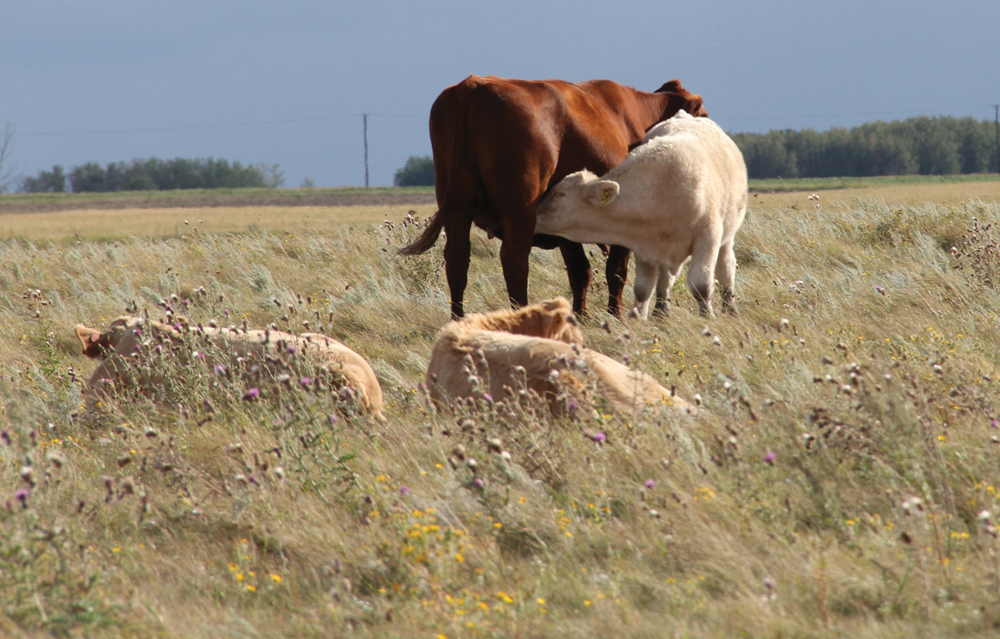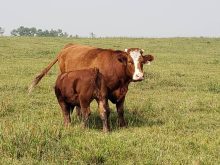Market analyst Jerry Klassen in his recent column isn’t painting a very bright cattle price outlook picture heading into this winter and early into 2017.
An oversupply of beef in the U.S. and Canada is holding prices down. And of course those pork guys continue to push more product out the door — a lot of competition for the protein dollar. Did you catch that number in Klassen’s column — beef and pork meat supplies are expected to be two BILLION pounds higher in 2017 compared to 2013 — that’s a lot of bacon cheeseburgers. There are some reduced meat prices at the retail level, but generally premium cuts of meat are holding their value. Consumer spending is at or near saturation.
Read Also

Harvest wraps up and fall work begins
At the Eppich famly ranch in western Saskatchewan, the fall harvest was successful with few breakdowns, cows and calves have been sorted and a new tractor has arrived
It takes a while for the beef industry in particular to respond to market signals, so there is no immediate relief in sight.
Klassen describes it as “sticker shock” for cow-calf producers heading to auctions this fall and seeing lower prices offered for calves. Buyers aren’t very interested in buying or as Klassen says “eyes begin to draw straws.”
And it will probably be a tough few months ahead again for feedlots. Western Feedlots perhaps shouldn’t have rushed to buy cattle about a year ago. The largest feeder in southern Alberta, by all accounts a pretty well-run business, decided this past summer it was closing shop after 60 years. That sent a clear message about what happens to a cattle feeder that loses money for too long with little relief in sight.
Not knowing much about the feeder industry, I asked a market expert about the basic economics of not only a 100,000-head operation like Western, but for feedlots in general.
It’s pretty simple. If a feedlot buys a 600-pound steer at $2 per pound and the animal is finished to 1,450 pounds, the break-even selling price is about $1.35 per pound. If they can’t get at least that break-even price, they begin to lose money.
Over just the past year (since late 2015), the feeding industry in general has lost about $280 per head, and there have been some periods when losses were as high as $400 per animal.
For an outfit like Western Feedlots with three yards, and a total capacity for 100,000 head at one time, any losses quickly add up. Most feeders will turn their inventory over 2-1/2 times, so in a yard capacity for 100,000 head that makes a total of 250,000 head of cattle per year. At a loss of $280 per head, multiplied by 250,000 head, the feeder is looking at a potential loss of $70 million per year. That translates into a hit of about $6 million a month, or about $200,000 per day. It takes some very deep pockets to cover that kind of loss.
Could these losses have been avoided? With increased production across the North American cattle industry — increased beef supply — it didn’t appear that finished cattle prices were likely to increase.
But, there are several reasons why a feeder stocked up last year. Some feeders ignored advice not to fill their pens in hopes of a rebound in finished cattle prices — the rebound hasn’t happened. After decent returns in 2014 and early 2015 some feeders also stocked up last fall to reduce the risk of paying taxes. And if a feedyard had 40 to 100 employees and full silage pits, that was another pressure to keep the place operating.
I don’t know if any feeder is making great money, but the yards that didn’t load up on higher-priced cattle last fall, and are waiting for lower feeder cattle prices this year, reduced their risk, and hopefully sit in a survival position.
Preconditioning potential
So what about the cow-calf producer? Klassen’s advice for the past few months has encouraged producers to consider backgrounding fall calves until prices at least improve a bit next spring.
Our longtime livestock nutrition columnist Peter Vitti isn’t talking about backgrounding in his most recent column but he did make an economic argument for preconditioning calves.
Preconditioning is one of those topics that gets tossed around, but doesn’t seem to gain wide spread acceptance. It was a hot topic about 15 years ago, at least here in Alberta, but there seemed to be a real push and even some incentives for calves that were weaned and started on feed at home before being marketed. But interest appears to have cooled.
Part of the problem I hear is that many cattle feeders don’t necessarily offer a price premium for preconditioned calves, which doesn’t send a very encouraging signal to cow-calf operators. “If I’m not getting paid extra for my time, trouble and expense, why do it?”
Vitti has some numbers which does show an economic benefit, and one operator he talked described how their Manitoba farm struck a deal with a local feeder to provide “certified preconditioned” calves. Usually there was a price premium, and for the producer it also made good economic sense to be able to deliver calves to a local feedlot at reduced trucking costs. So that makes the case — even if the price isn’t higher, perhaps costs are reduced.
And preconditioning program can benefit cattle feeders. There are several preconditioning programs in the U.S. that offer price premiums. At a pr-conditioning session at the Canadian Beef Industry Conference in Calgary last summer it was noted the cold weaning and shipping to auction takes its toll on calves. Weaning itself is very stressful on calves and then several other factors are stressful too. Research shows it can take five days for a weaned calf to get from the farm into a feedyard.
Research further shows that up to 30 per cent of those calves will need to be treated for some type of Bovine Respiratory Disease (BRD) at the feedyard, and on average 7.5 per cent of them will die. That in itself represents an economic loss of about $8 million in Western Canada, never mind the delay in rate of gain on those calves that were treated and lived.
So what are the requirements of pre-conditioning? There are four basic components.
- Calves must be weaned for a minimum of 45 days.
- Calves need to be vaccinated and boostered with IBR, BVD, BRSV, P13, clostridial vaccine and Pasteurella Pneumonia at least 21 days prior to sale.
- Calves need to be castrated, dehorned and healed, dewormed and treated for external parasites at least 21 days prior to sale.
- And calves need to be introduced to processed feedstuffs, feedbunks and waterbowls, commonly referred to as “bunk-breaking.” And if it’s an official preconditioning program they might also need to be tagged and receive a veterinary verification.

Oliver Schunicht, who produces cattle in southern Alberta, told the conference he makes money at preconditioning calves, even though feeders don’t necessarily pay a premium.
Schunicht says over five years of preconditioning calves he’s been able to realize a profit every year. Schunicht says for him the key isn’t about expecting a higher price, it is about keeping the calves long enough to make money on their increased gain.
He says for his farm near Rockyford, east of Calgary, he has to keep calves for at least 60 days and ideally for 75 days before marketing.
As producers look at preconditioning, he says they need to consider a few things. Do they have the proper facilities for preconditioning? Calves need to properly processed and also given access to feed bunks. Ideally calves should be weighed in and weighed out, and treated with a proper vaccination program that can be developed with their herd veterinarian. Producers will also need equipment to feed these calves, and it might require the investment in some type of mill so grain can be rolled.
Schunicht says at his farm he already had two full-time employees on staff, so diverting their time to feed calves wasn’t a big issue. He estimated it took about two hours per day to tend the calves.
He fed a ration that was about 70 per cent silage and 17 per cent hay with the balance in barley and supplement. He targeted a gain of two to 2.5 pounds per day. He could have fed to achieve three pounds of gain per day, but figures the calves would have been too fleshy.
His calves stay on this ration for 75 days and in recent years he has marketed through a video auction service, so the calves are filmed on the farm and don’t have to be trucked to the sale ring. While he doesn’t necessarily see a premium, his calves have typically sold in the top of the Canfax price range. And he says once feeders see the value in these calves one year, they may be more inclined to seek them out another year.
















